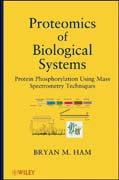
Proteomics of biological systems: protein phosphorylation using mass spectrometry techniques
Ham, Bryan M.
Phosphorylation is the addition of a phosphate (PO4) group to a protein or other organic molecule. Phosphorylation activates or deactivates many protein enzymes, causing or preventing the mechanisms of diseases such as cancer and diabetes. This book shows how to use mass spectrometry to determine whether or not a protein has been correctly modified by the addition of a phosphate group. It also provides a combination of detailed, step-by-step methodology for phosphoproteomic sample preparation, mass spectral instrumental analysis, and data interpretation approaches. Furthermore, it includes the use of bioinformatic Internet tools such as the Blast2GO gene ontology (GO) tool, used to help understand and interpret complex data collected in these studies. INDICE: Preface. Acknowledgements. Dedication. Glossary, Abbreviations, and Definitions. 1. Post Translational Modification of Proteins (PTM). 1.1 Over 200 Forms of PTM of Proteins. 1.2 Three Main Types of PTM Studied by Mass Spectrometry. 1.3 Overview of Nano-electrospray/nano-flow Liquid Chromatography Mass Spectrometry. 1.4 Overview of Nucleic Acids. 1.5 Proteins and Proteomics. 1.6 References. 2. Glycosylation of Proteins. 2.1 Production of a Glycoprotein.2.2 Biological Processes of Protein Glycoslyation. 2.3 N-linked and O-linked Glycosylation. 2.4 Carbohydrates. 2.5 Three Objectives in Studying Glycoproteins. 2.6 Glycosylation Study Approaches. 2.7 References. 3. Sulfation of Proteins as Post Translational Modification. 3.1 Glycosaminoglycan Sulfation. 3.2 Cellular Processes Involved in Sulfation. 3.3 Brief Example of Phosphorylation. 3.4 Sulfotransferase Class of Enzymes. 3.5 Fragmentation Nomenclature for Carbohydrates. 3.6 Sulfated Mucin Oligosaccharides. 3.7 Tyrosine Sulfation. 3.8 Tyrosylprotein Sulfotransferases TPST1 and TPST2. 3.9 O-sulfated Human Proteins.3.10 Sulfated Peptide Product Ion Spectra. 3.11 Use of Higher Energy Collisions. 3.12 Electron Capture Dissociation (ECD). 3.13 Sulfation versus Phosphorylation. 3.14 References. 4. Eukaryote PTM as Phosohorylation: Normal State Studies. 4.1 Mass Spectral Measurement with Examples of HeLa Cell Phosphoproteome.4.2 The HeLa Cell Phosphoproteome. 4.3 Non-phosphoproteome HeLa Cell Anaysis.4.4 References. 4.5 Reviewing Spectra Using the SpectrumLook Software Package. 5. Eukaryote PTM as Phosphorylation: Perturbed State Studies. 5.1 Study of the Phosphoproteome of HeLa Cells under Perturbed Conditions by nano-HPLC ESI LTQ-FT/MS. 6. Prokaryotic Phosphorylation of Serine, Threonine, and Tyrosine. 6.1 Introduction. 6.2 Optimized Methodology for Phospho Ser/Thr/Tyr Studies. 6.3 Identification of the Components of the Serine/Threonine/Tyrosine Phosphoproteome in Caulobacter crescentus Growth in the Presence and Absence of Glucose.7. Prokaryotic Phosphorylation of Histidine. 7.1 Phosphohistidine as Post Translational Modification. 7.2 Bacterial Kinases and the Two-Component System. 7.3 Measurement of Phosphorylated Histidine. 7.4 In-vitro and In-vivo Study of Phosphorylated Histidine Containing Peptides by Nano-ESI Tandem Mass Spectrometry. 7.5 Supplementary Material. Appendix I. Atomic Weights and Isotopic Compositions. Appendix II. Periodic Table. Appendix III. Fundamental Physical Constants. Index.
- ISBN: 978-1-118-02896-4
- Editorial: John Wiley & Sons
- Encuadernacion: Cartoné
- Páginas: 376
- Fecha Publicación: 28/10/2011
- Nº Volúmenes: 1
- Idioma: Inglés
